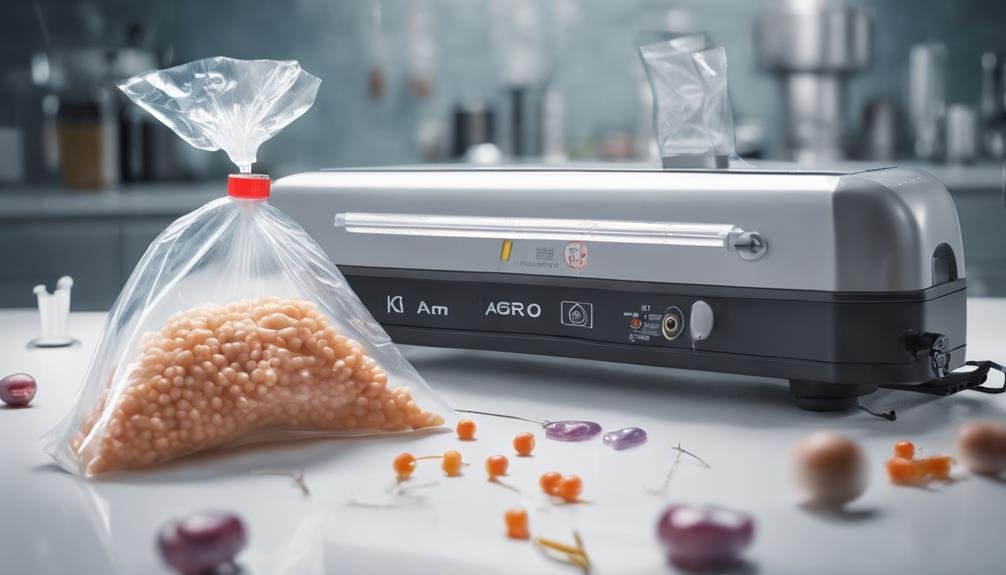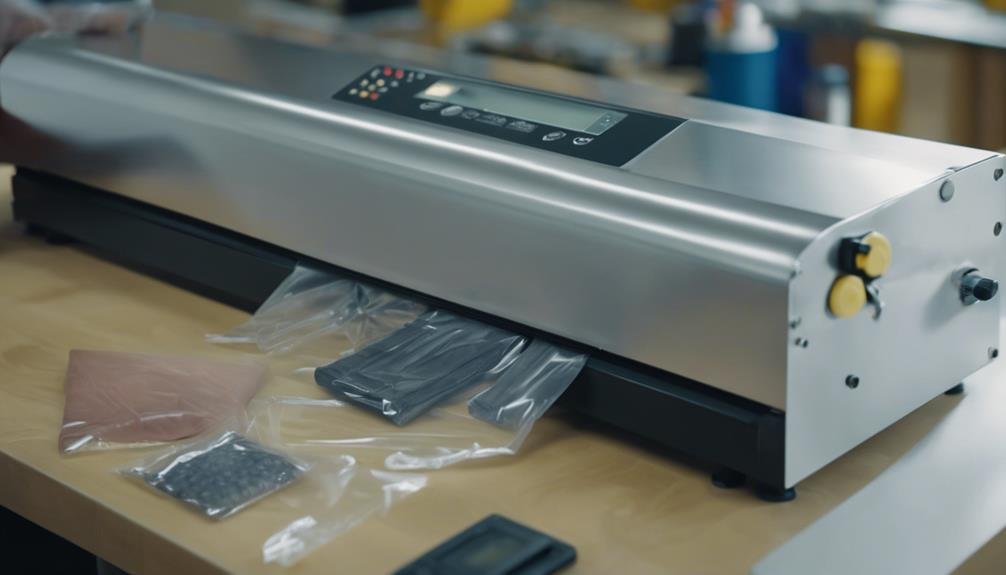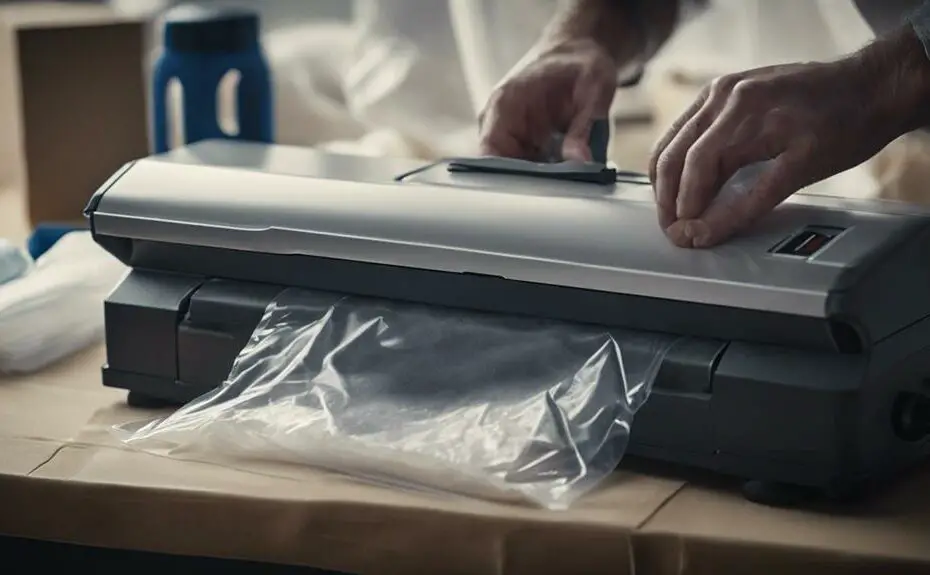When vacuum sealing non-food items, begin by choosing durable, puncture-resistant vacuum bags. Utilize a high-quality vacuum sealer with adjustable settings for a secure seal. Ensure your items are dry and consider using desiccant packets for added moisture control. For fragile or bulky items, you can enhance the process by using an external air compressor and incorporating inert gases to remove oxygen. Whether you are sealing important documents, preserving clothing, safeguarding electronics, or protecting tools, vacuum sealing can help maintain their integrity and prolong their lifespan. Stay tuned to learn about the best techniques for sealing each type of item.
Selecting the Right Vacuum Bags
When selecting vacuum bags for non-food items, it is vital to consider the material's thickness for the best protection and durability. Thicker vacuum bags are less likely to puncture, offering better security for your belongings. This is particularly important if you're storing items with sharp edges or irregular shapes.
You also need to make sure the vacuum bags you choose are puncture-resistant. This feature is important to prevent damage during storage or transportation. A puncture-resistant bag will maintain its integrity, ensuring an airtight seal that keeps your items safe from moisture, dust, and other environmental factors.
Moreover, opt for vacuum bags with a smooth interior surface. This helps in avoiding any snagging or tearing of delicate items. Smooth interiors make it easier to slide in items like fabrics or papers without causing damage.
Transparent vacuum bags can be especially useful. They allow you to see the contents at a glance, making it much easier to locate specific items without opening multiple bags. Finally, consider vacuum bags with a zippered closure. This allows you to reuse the bags, accessing your items without compromising the airtight seal.
Choosing a Vacuum Sealer
After selecting the right vacuum bags, you'll need a reliable vacuum sealer to make sure your non-food items are properly protected. First, consider a vacuum sealer with adjustable settings. This feature ensures you can tailor the sealing process to your specific needs. For delicate items, look for a model with a manual mode, which gives you greater control and prevents damage during sealing.
A strong seal bar and durable construction are essential. These elements guarantee that your vacuum sealer can handle the rigors of sealing non-food items securely and consistently. It's also beneficial to choose a vacuum sealer that offers different sealing options like dry, moist, and gentle settings. This versatility allows you to seal a wide range of items effectively.
Bag sizes matter, too. Make sure the vacuum sealer you pick is compatible with various bag sizes and materials. This flexibility will enable you to seal everything from small, delicate items to larger, bulkier ones. By selecting a vacuum sealer with these features, you'll be well-equipped to protect and preserve your non-food items efficiently.
Preparing Items for Sealing

Before vacuum sealing, make sure your non-food items are completely dry and free of moisture to prevent any potential damage. Moisture can lead to mold or mildew, especially on items like dry clothing and paper documents. To guarantee the best results, lay out your items in a dry, well-ventilated area prior to sealing.
Next, choose the appropriate plastic bags or vacuum pouches designed specifically for non-food items. These bags typically offer better protection and guarantee a tighter seal. For added preservation, consider inserting desiccant packets or oxygen absorbers into the bags. These small additions can greatly enhance the longevity of your stored items by further reducing moisture and oxygen levels inside the vacuum seal.
When it comes to organizing, labeling is key. Clearly mark each sealed bag with its contents and the date you sealed it. This simple step will save you time and frustration when you're searching for specific items later on.
Using External Air Compressors
To enhance the efficiency of your vacuum sealing process, consider using an external air compressor for added suction power. An external air compressor can greatly improve the removal of air from bags containing non-food items. By connecting the air compressor to your vacuum sealer, you can achieve a tighter vacuum seal, ensuring better preservation and storage for items like clothing, documents, and electronics.
External air compressors provide additional suction power, which is especially useful for sealing delicate or bulky items. The extra suction ensures that air is thoroughly removed, resulting in a more secure and effective seal. You can also customize the suction level to suit different types of non-food items, providing flexibility and precision in your vacuum sealing process.
Here's a quick comparison of using a vacuum sealer with and without an external air compressor:
| Aspect | Without External Air Compressor | With External Air Compressor |
|---|---|---|
| Suction Power | Standard | Enhanced |
| Seal Effectiveness | Moderate | High |
| Customization of Suction Level | Limited | High |
| Suitable for Delicate Items | Less Effective | More Effective |
Incorporating Inert Gases

Pairing your vacuum sealing system with inert gases like nitrogen can further elevate the preservation of non-food items by eliminating oxygen. When you use nitrogen in vacuum sealing, you guarantee that no oxygen remains inside the package, effectively preventing oxidation and deterioration. This method is especially important in industries where maintaining product quality and longevity is vital.
By displacing oxygen, inert gases like nitrogen create a stable environment within the vacuum-sealed package. This stability reduces the risk of moisture buildup and mold growth, which can damage sensitive non-food items. Whether you're storing electronic components, medical supplies, or archival materials, incorporating inert gases in your vacuum sealing process can greatly extend the lifespan and reliability of these items.
Incorporating inert gases is a simple yet powerful enhancement to your vacuum sealing strategy. It helps maintain the integrity and functionality of your non-food items over extended periods. By ensuring an oxygen-free environment, you're taking a proactive step towards superior preservation. So, if you're serious about maximizing the shelf life and condition of your non-food items, don't overlook the benefits of using inert gases like nitrogen in your vacuum sealing process.
Sealing Important Documents
Vacuum sealing important documents is an effective way to protect them from water damage, dust, and other environmental factors. By using a vacuum seal, you can prevent yellowing, fading, and deterioration of your critical paperwork over time. This method is particularly useful for organizing and securely storing essential documents such as birth certificates, passports, and property titles.
In case of an emergency fire, having your documents vacuum sealed adds an extra layer of protection. While the vacuum seal won't make them fireproof, it helps in safeguarding against secondary damage like water from firefighting efforts or exposure to soot and debris. This is vital for emergency preparedness, ensuring that your essential records remain intact and accessible when needed most.
Additionally, vacuum sealing isn't just for emergencies. It's also beneficial for travel and archival purposes. When you vacuum seal your documents, you make them more portable and less prone to accidental damage during transit. For archival purposes, this method helps maintain the integrity of historical documents, keeping them in pristine condition for future generations.
Incorporating a vacuum seal into your document preservation strategy is a smart, practical way to guarantee their longevity and security.
Preserving Clothing and Textiles

Preserving clothing and textiles by vacuum sealing them keeps your items safe from moisture, dust, and pests. By using vacuum-sealed protective bags, you can guarantee that your seasonal clothing remains fresh and ready for use when needed. These bags are excellent for storing bulky items like blankets, bedding, and linens, allowing you to save considerable space in your storage areas.
For delicate fabrics such as wool, cashmere, and silk, vacuum sealing is an effective method to maintain their integrity. Place these items in protective bags to shield them from environmental damage. This technique is particularly useful for preserving heirloom textiles, costumes, and vintage clothing, ensuring they remain in pristine condition for years.
When vacuum sealing your clothing, make sure to fold items neatly and avoid overpacking the bags. This will help maintain the shape and quality of the fabrics. Also, label each bag clearly so you can find your items easily when needed. By incorporating vacuum sealing into your clothing preservation routine, you'll safeguard your valuable textiles and maximize your storage efficiency, making it a smart and practical solution for any household.
Vacuum Sealing Electronic Devices
Protecting your electronic devices from moisture and dust is easy when you vacuum seal them in appropriate bags. By vacuum sealing, you create a waterproof barrier that shields your gadgets from environmental elements. This technique is particularly useful for preventing oxidation and corrosion of sensitive electronic components, guaranteeing they stay in top condition.
To get started, make sure you've got the right bags designed for vacuum sealing electronic devices. Place your device inside the bag, ensuring it's properly cushioned to avoid any damage during the sealing process. Adding items like spare batteries, chargers, and cables can also be beneficial, as it keeps everything compact and protected.
When you vacuum seal your electronic devices, you're not just keeping them safe from moisture and dust. You're also preparing them for outdoor activities or emergencies where exposure to harsh conditions is likely. Remember to double-check the seal to make sure it's airtight and the waterproof barrier is intact.
This method is a simple yet effective way to extend the lifespan of your electronic gadgets. With minimal effort, you can guarantee your devices remain functional and ready for use whenever you need them.
Protecting Tools and Hardware

Just as vacuum sealing can safeguard your electronic devices, it can also keep your tools and hardware in top condition. By vacuum sealing tools and hardware, you're protecting them from rust, corrosion, and moisture damage. This method works great for items like wrenches, screwdrivers, and pliers, keeping them organized and easily accessible.
When you vacuum seal your tools, you prevent oxidation, which extends their shelf life. No more dealing with rusted or corroded tools that are difficult to use. By using vacuum-sealed bags or containers, you maintain the quality of your tools and hardware, ensuring they remain as effective as the day you bought them.
Moreover, vacuum sealing helps prevent tools from getting misplaced or lost in a cluttered workspace. Everything stays neatly packed and easy to find when you need it. Imagine reaching into your toolbox and finding every tool exactly where it should be, in perfect condition.
Incorporating vacuum sealing into your storage routine is a simple yet effective way to protect your investment in tools and hardware. It keeps them in peak condition, ensuring they're always ready for the next project.
Conclusion
You've now got the know-how to vacuum seal anything from delicate documents to robust tools. While preserving food keeps it fresh, sealing non-food items keeps them safe and organized. Imagine securing your grandmother's quilt next to your high-tech gadgets, both protected with the same technique. It's not just about preservation; it's about peace of mind. So go ahead, seal your world, and keep your treasures intact for years to come.
